SAAB 9-5 2009 Owner's Manual
Manufacturer: SAAB, Model Year: 2009, Model line: 9-5, Model: SAAB 9-5 2009Pages: 272, PDF Size: 21.53 MB
Page 21 of 272
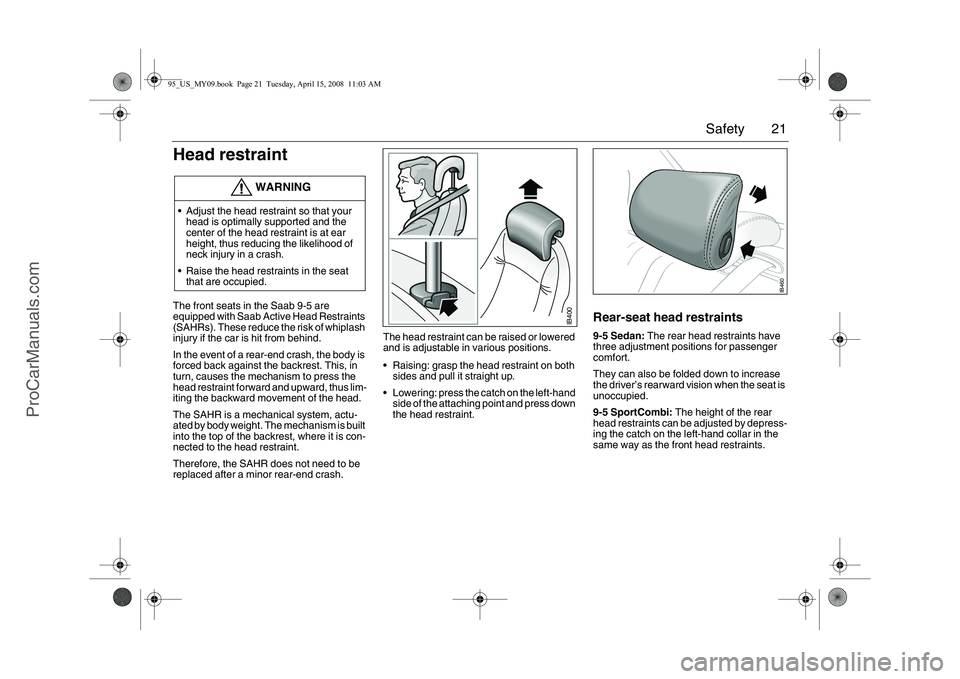
21 Safety
Head restraintThe front seats in the Saab 9-5 are
equipped with Saab Active Head Restraints
(SAHRs). These reduce the risk of whiplash
injury if the car is hit from behind.
In the event of a rear-end crash, the body is
forced back against the backrest. This, in
turn, causes the mechanism to press the
head restraint forward and upward, thus lim-
iting the backward movement of the head.
The SAHR is a mechanical system, actu-
ated by body weight. The mechanism is built
into the top of the backrest, where it is con-
nected to the head restraint.
Therefore, the SAHR does not need to be
replaced after a minor rear-end crash.The head restraint can be raised or lowered
and is adjustable in various positions.
Raising: grasp the head restraint on both
sides and pull it straight up.
Lowering: press the catch on the left-hand
side of the attaching point and press down
the head restraint.
Rear-seat head restraints9-5 Sedan: The rear head restraints have
three adjustment positions for passenger
comfort.
They can also be folded down to increase
the driver’s rearward vision when the seat is
unoccupied.
9-5 SportCombi: The height of the rear
head restraints can be adjusted by depress-
ing the catch on the left-hand collar in the
same way as the front head restraints.
WARNING
Adjust the head restraint so that your
head is optimally supported and the
center of the head restraint is at ear
height, thus reducing the likelihood of
neck injury in a crash.
Raise the head restraints in the seat
that are occupied.
IB400
IB460
95_US_MY09.book Page 21 Tuesday, April 15, 2008 11:03 AM
ProCarManuals.com
Page 22 of 272
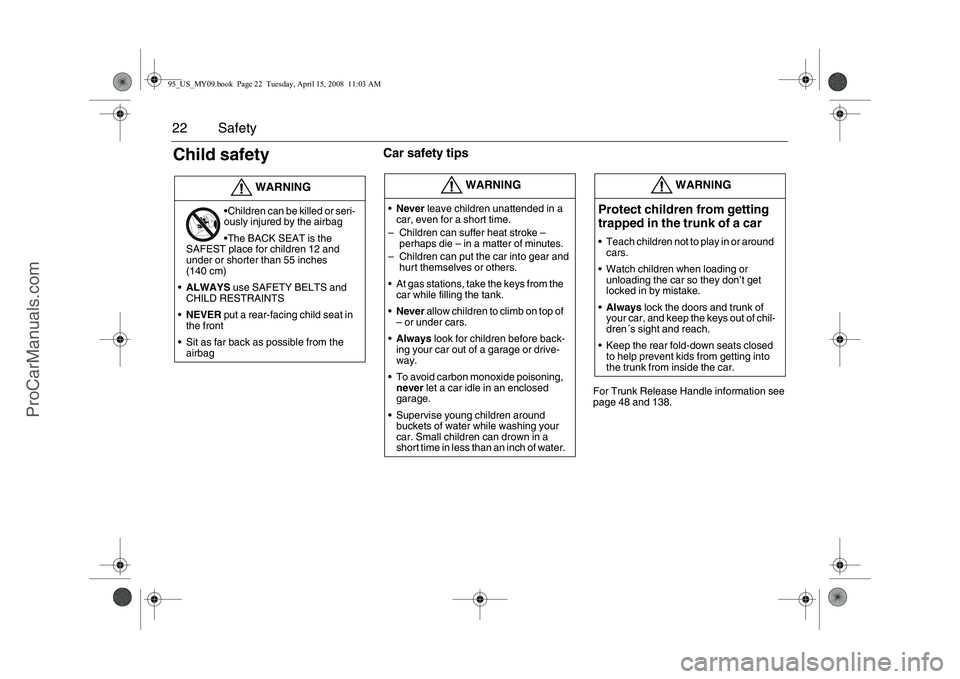
22 SafetyChild safety
Car safety tips
For Trunk Release Handle information see
page 48 and 138.
WARNING
Children can be killed or seri-
ously injured by the airbag
The BACK SEAT is the
SAFEST place for children 12 and
under or shorter than 55 inches
(140 cm)
ALWAYS use SAFETY BELTS and
CHILD RESTRAINTS
NEVER put a rear-facing child seat in
the front
Sit as far back as possible from the
airbag
WARNING
Never leave children unattended in a
car, even for a short time.
– Children can suffer heat stroke –
perhaps die – in a matter of minutes.
– Children can put the car into gear and
hurt themselves or others.
At gas stations, take the keys from the
car while filling the tank.
Never allow children to climb on top of
– or under cars.
Always look for children before back-
ing your car out of a garage or drive-
way.
To avoid carbon monoxide poisoning,
never let a car idle in an enclosed
garage.
Supervise young children around
buckets of water while washing your
car. Small children can drown in a
short time in less than an inch of water.
WARNING
Protect children from getting
trapped in the trunk of a car Teach children not to play in or around
cars.
Watch children when loading or
unloading the car so they don’t get
locked in by mistake.
Always lock the doors and trunk of
your car, and keep the keys out of chil-
dren´s sight and reach.
Keep the rear fold-down seats closed
to help prevent kids from getting into
the trunk from inside the car.
95_US_MY09.book Page 22 Tuesday, April 15, 2008 11:03 AM
ProCarManuals.com
Page 23 of 272
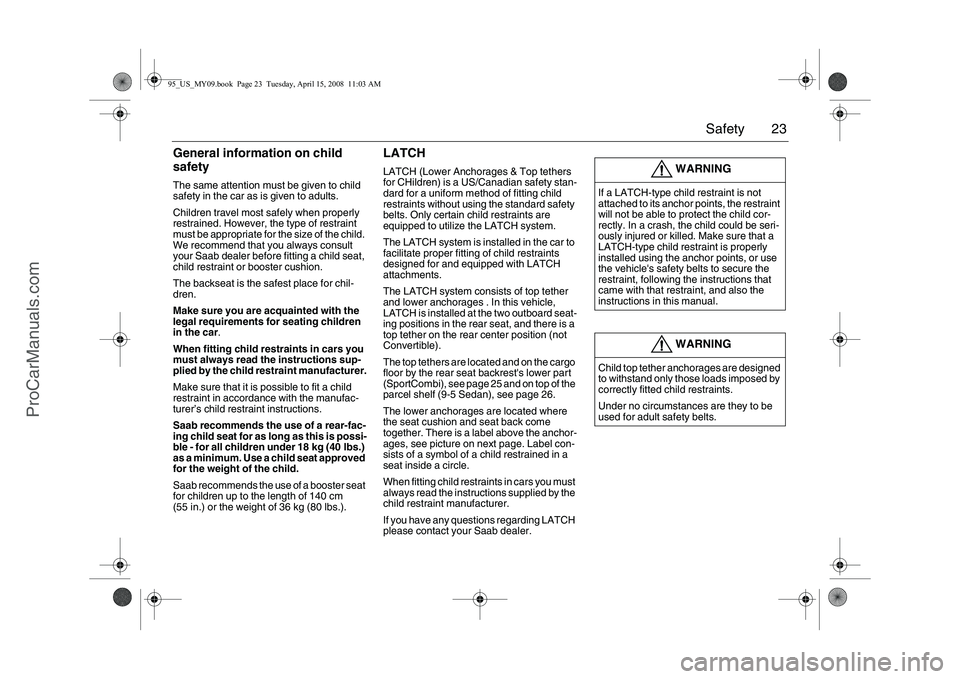
23 Safety
General information on child
safetyThe same attention must be given to child
safety in the car as is given to adults.
Children travel most safely when properly
restrained. However, the type of restraint
must be appropriate for the size of the child.
We recommend that you always consult
your Saab dealer before fitting a child seat,
child restraint or booster cushion.
The backseat is the safest place for chil-
dren.
Make sure you are acquainted with the
legal requirements for seating children
in the car.
When fitting child restraints in cars you
must always read the instructions sup-
plied by the child restraint manufacturer.
Make sure that it is possible to fit a child
restraint in accordance with the manufac-
turer’s child restraint instructions.
Saab recommends the use of a rear-fac-
ing child seat for as long as this is possi-
ble - for all children under 18 kg (40 lbs.)
as a minimum. Use a child seat approved
for the weight of the child.
Saab recommends the use of a booster seat
for children up to the length of 140 cm
(55 in.) or the weight of 36 kg (80 lbs.).
LATCHLATCH (Lower Anchorages & Top tethers
for CHildren) is a US/Canadian safety stan-
dard for a uniform method of fitting child
restraints without using the standard safety
belts. Only certain child restraints are
equipped to utilize the LATCH system.
The LATCH system is installed in the car to
facilitate proper fitting of child restraints
designed for and equipped with LATCH
attachments.
The LATCH system consists of top tether
and lower anchorages . In this vehicle,
LATCH is installed at the two outboard seat-
ing positions in the rear seat, and there is a
top tether on the rear center position (not
Convertible).
The top tethers are located and on the cargo
floor by the rear seat backrest's lower part
(SportCombi), see page 25 and on top of the
parcel shelf (9-5 Sedan), see page 26.
The lower anchorages are located where
the seat cushion and seat back come
together. There is a label above the anchor-
ages, see picture on next page. Label con-
sists of a symbol of a child restrained in a
seat inside a circle.
When fitting child restraints in cars you must
always read the instructions supplied by the
child restraint manufacturer.
If you have any questions regarding LATCH
please contact your Saab dealer.
WARNING
If a LATCH-type child restraint is not
attached to its anchor points, the restraint
will not be able to protect the child cor-
rectly. In a crash, the child could be seri-
ously injured or killed. Make sure that a
LATCH-type child restraint is properly
installed using the anchor points, or use
the vehicle's safety belts to secure the
restraint, following the instructions that
came with that restraint, and also the
instructions in this manual.
WARNING
Child top tether anchorages are designed
to withstand only those loads imposed by
correctly fitted child restraints.
Under no circumstances are they to be
used for adult safety belts.
95_US_MY09.book Page 23 Tuesday, April 15, 2008 11:03 AM
ProCarManuals.com
Page 24 of 272
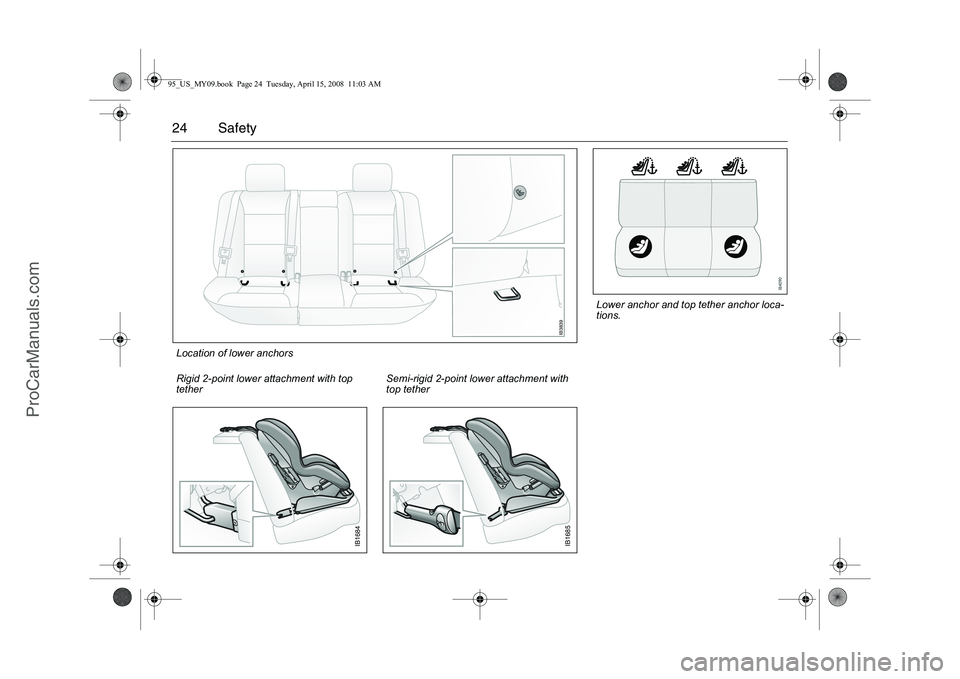
24 Safety
IB1684
Rigid 2-point lower attachment with top
tether
IB1685
Semi-rigid 2-point lower attachment with
top tether
IB3839
Location of lower anchors
Lower anchor and top tether anchor loca-
tions.
95_US_MY09.book Page 24 Tuesday, April 15, 2008 11:03 AM
ProCarManuals.com
Page 25 of 272
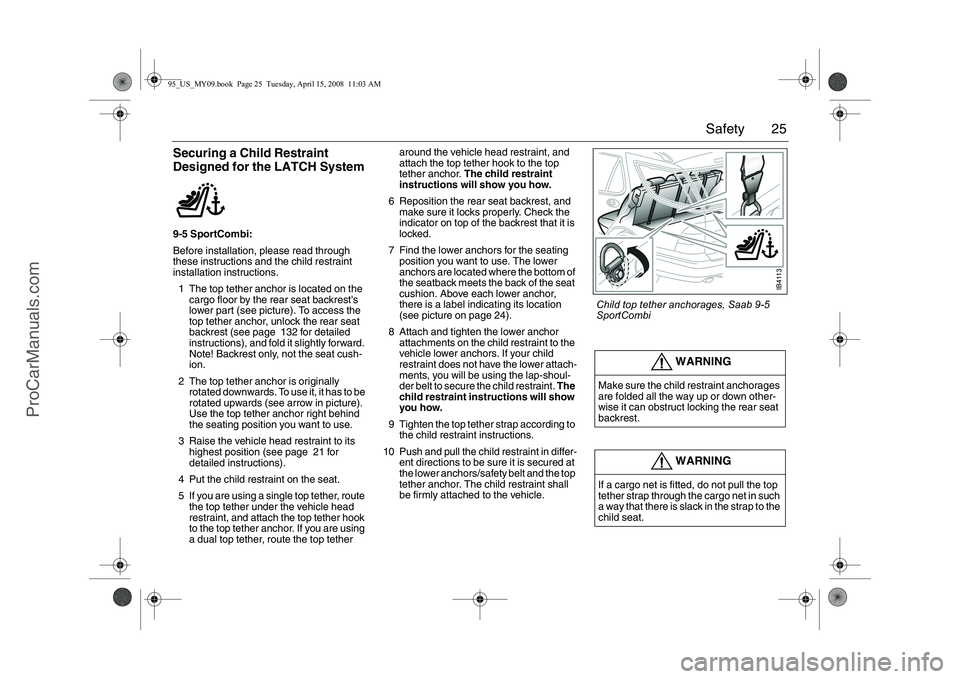
25 Safety
Securing a Child Restraint
Designed for the LATCH System9-5 SportCombi:
Before installation, please read through
these instructions and the child restraint
installation instructions.
1 The top tether anchor is located on the
cargo floor by the rear seat backrest's
lower part (see picture). To access the
top tether anchor, unlock the rear seat
backrest (see page 132 for detailed
instructions), and fold it slightly forward.
Note! Backrest only, not the seat cush-
ion.
2 The top tether anchor is originally
rotated downwards. To use it, it has to be
rotated upwards (see arrow in picture).
Use the top tether anchor right behind
the seating position you want to use.
3 Raise the vehicle head restraint to its
highest position (see page 21 for
detailed instructions).
4 Put the child restraint on the seat.
5 If you are using a single top tether, route
the top tether under the vehicle head
restraint, and attach the top tether hook
to the top tether anchor. If you are using
a dual top tether, route the top tether around the vehicle head restraint, and
attach the top tether hook to the top
tether anchor. The child restraint
instructions will show you how.
6 Reposition the rear seat backrest, and
make sure it locks properly. Check the
indicator on top of the backrest that it is
locked.
7 Find the lower anchors for the seating
position you want to use. The lower
anchors are located where the bottom of
the seatback meets the back of the seat
cushion. Above each lower anchor,
there is a label indicating its location
(see picture on page 24).
8 Attach and tighten the lower anchor
attachments on the child restraint to the
vehicle lower anchors. If your child
restraint does not have the lower attach-
ments, you will be using the lap-shoul-
der belt to secure the child restraint. The
child restraint instructions will show
you how.
9 Tighten the top tether strap according to
the child restraint instructions.
10 Push and pull the child restraint in differ-
ent directions to be sure it is secured at
the lower anchors/safety belt and the top
tether anchor. The child restraint shall
be firmly attached to the vehicle.
WARNING
Make sure the child restraint anchorages
are folded all the way up or down other-
wise it can obstruct locking the rear seat
backrest.
WARNING
If a cargo net is fitted, do not pull the top
tether strap through the cargo net in such
a way that there is slack in the strap to the
child seat.
IB4113
Child top tether anchorages, Saab 9-5
SportCombi
95_US_MY09.book Page 25 Tuesday, April 15, 2008 11:03 AM
ProCarManuals.com
Page 26 of 272
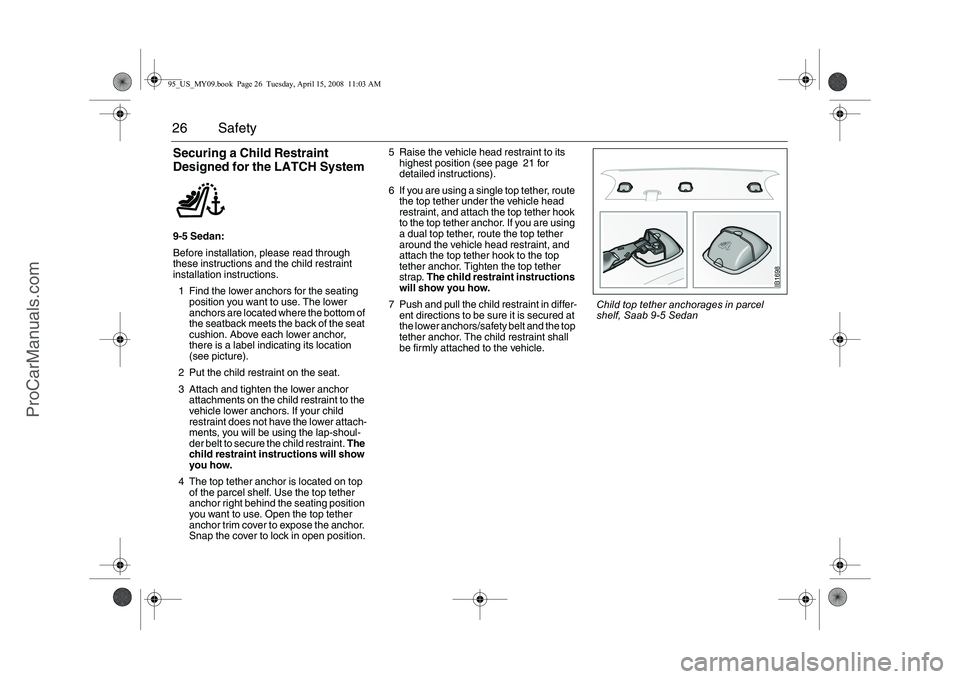
26 SafetySecuring a Child Restraint
Designed for the LATCH System 9-5 Sedan:
Before installation, please read through
these instructions and the child restraint
installation instructions.
1 Find the lower anchors for the seating
position you want to use. The lower
anchors are located where the bottom of
the seatback meets the back of the seat
cushion. Above each lower anchor,
there is a label indicating its location
(see picture).
2 Put the child restraint on the seat.
3 Attach and tighten the lower anchor
attachments on the child restraint to the
vehicle lower anchors. If your child
restraint does not have the lower attach-
ments, you will be using the lap-shoul-
der belt to secure the child restraint. The
child restraint instructions will show
you how.
4 The top tether anchor is located on top
of the parcel shelf. Use the top tether
anchor right behind the seating position
you want to use. Open the top tether
anchor trim cover to expose the anchor.
Snap the cover to lock in open position.5 Raise the vehicle head restraint to its
highest position (see page 21 for
detailed instructions).
6 If you are using a single top tether, route
the top tether under the vehicle head
restraint, and attach the top tether hook
to the top tether anchor. If you are using
a dual top tether, route the top tether
around the vehicle head restraint, and
attach the top tether hook to the top
tether anchor. Tighten the top tether
strap. The child restraint instructions
will show you how.
7 Push and pull the child restraint in differ-
ent directions to be sure it is secured at
the lower anchors/safety belt and the top
tether anchor. The child restraint shall
be firmly attached to the vehicle.
IB1698
Child top tether anchorages in parcel
shelf, Saab 9-5 Sedan
95_US_MY09.book Page 26 Tuesday, April 15, 2008 11:03 AM
ProCarManuals.com
Page 27 of 272
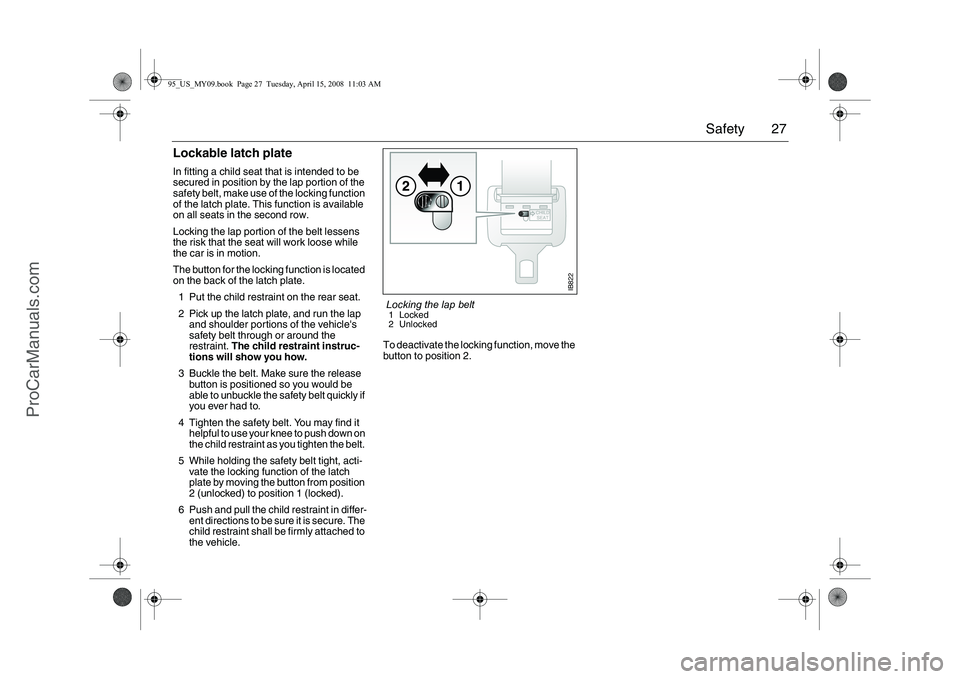
27 Safety
Lockable latch plateIn fitting a child seat that is intended to be
secured in position by the lap portion of the
safety belt, make use of the locking function
of the latch plate. This function is available
on all seats in the second row.
Locking the lap portion of the belt lessens
the risk that the seat will work loose while
the car is in motion.
The button for the locking function is located
on the back of the latch plate.
1 Put the child restraint on the rear seat.
2 Pick up the latch plate, and run the lap
and shoulder portions of the vehicle's
safety belt through or around the
restraint. The child restraint instruc-
tions will show you how.
3 Buckle the belt. Make sure the release
button is positioned so you would be
able to unbuckle the safety belt quickly if
you ever had to.
4 Tighten the safety belt. You may find it
helpful to use your knee to push down on
the child restraint as you tighten the belt.
5 While holding the safety belt tight, acti-
vate the locking function of the latch
plate by moving the button from position
2 (unlocked) to position 1 (locked).
6 Push and pull the child restraint in differ-
ent directions to be sure it is secure. The
child restraint shall be firmly attached to
the vehicle.To deactivate the locking function, move the
button to position 2.
IB822
Locking the lap belt1Locked
2 Unlocked
95_US_MY09.book Page 27 Tuesday, April 15, 2008 11:03 AM
ProCarManuals.com
Page 28 of 272
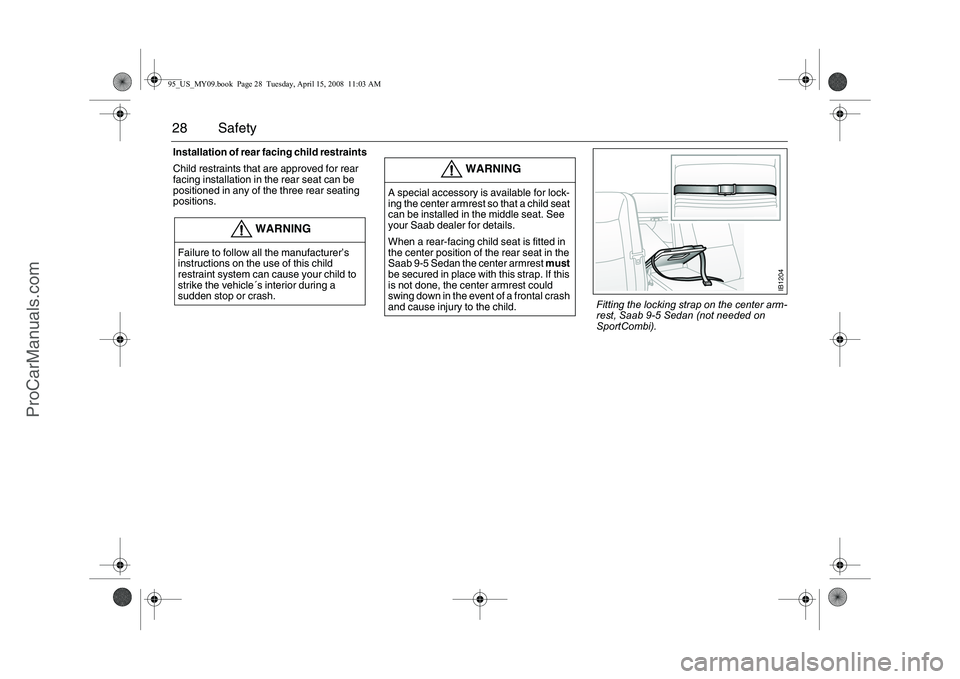
28 SafetyInstallation of rear facing child restraints
Child restraints that are approved for rear
facing installation in the rear seat can be
positioned in any of the three rear seating
positions.
WARNING
Failure to follow all the manufacturer’s
instructions on the use of this child
restraint system can cause your child to
strike the vehicle´s interior during a
sudden stop or crash.
WARNING
A special accessory is available for lock-
ing the center armrest so that a child seat
can be installed in the middle seat. See
your Saab dealer for details.
When a rear-facing child seat is fitted in
the center position of the rear seat in the
Saab 9-5 Sedan the center armrest must
be secured in place with this strap. If this
is not done, the center armrest could
swing down in the event of a frontal crash
and cause injury to the child.
IB1204
Fitting the locking strap on the center arm-
rest, Saab 9-5 Sedan (not needed on
SportCombi).
95_US_MY09.book Page 28 Tuesday, April 15, 2008 11:03 AM
ProCarManuals.com
Page 29 of 272
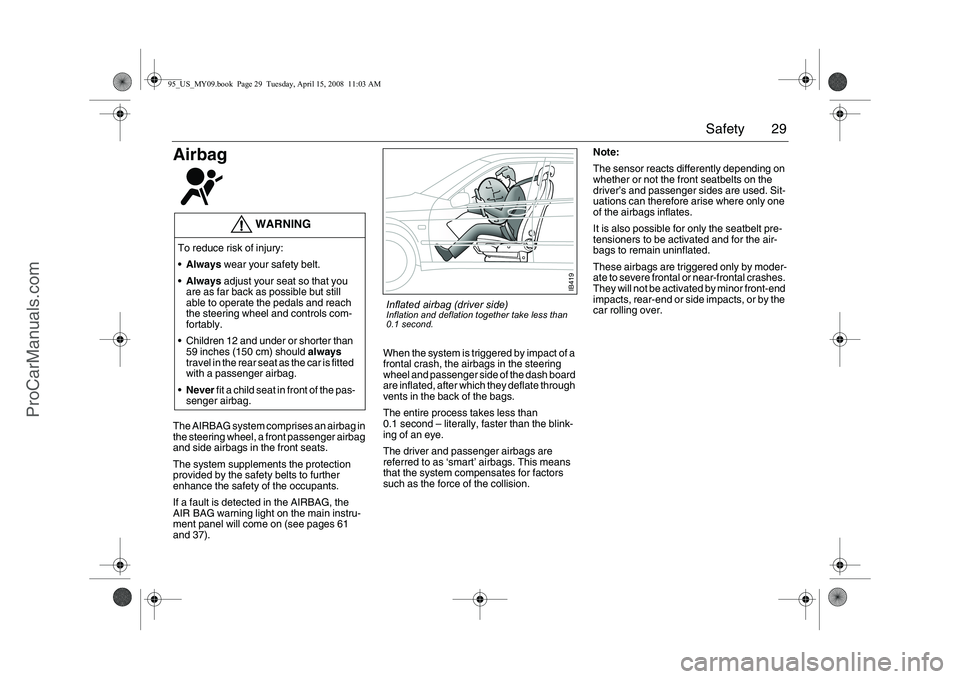
29 Safety
Airbag The AIRBAG system comprises an airbag in
the steering wheel, a front passenger airbag
and side airbags in the front seats.
The system supplements the protection
provided by the safety belts to further
enhance the safety of the occupants.
If a fault is detected in the AIRBAG, the
AIR BAG warning light on the main instru-
ment panel will come on (see pages 61
and 37). When the system is triggered by impact of a
frontal crash, the airbags in the steering
wheel and passenger side of the dash board
are inflated, after which they deflate through
vents in the back of the bags.
The entire process takes less than
0.1 second – literally, faster than the blink-
ing of an eye.
The driver and passenger airbags are
referred to as ‘smart’ airbags. This means
that the system compensates for factors
such as the force of the collision.Note:
The sensor reacts differently depending on
whether or not the front seatbelts on the
driver’s and passenger sides are used. Sit-
uations can therefore arise where only one
of the airbags inflates.
It is also possible for only the seatbelt pre-
tensioners to be activated and for the air-
bags to remain uninflated.
These airbags are triggered only by moder-
ate to severe frontal or near-frontal crashes.
They will not be activated by minor front-end
impacts, rear-end or side impacts, or by the
car rolling over.
WARNING
To reduce risk of injury:
Always wear your safety belt.
Always adjust your seat so that you
are as far back as possible but still
able to operate the pedals and reach
the steering wheel and controls com-
fortably.
Children 12 and under or shorter than
59 inches (150 cm) should always
travel in the rear seat as the car is fitted
with a passenger airbag.
Never fit a child seat in front of the pas-
senger airbag.
IB419
Inflated airbag (driver side) Inflation and deflation together take less than
0.1 second.
95_US_MY09.book Page 29 Tuesday, April 15, 2008 11:03 AM
ProCarManuals.com
Page 30 of 272
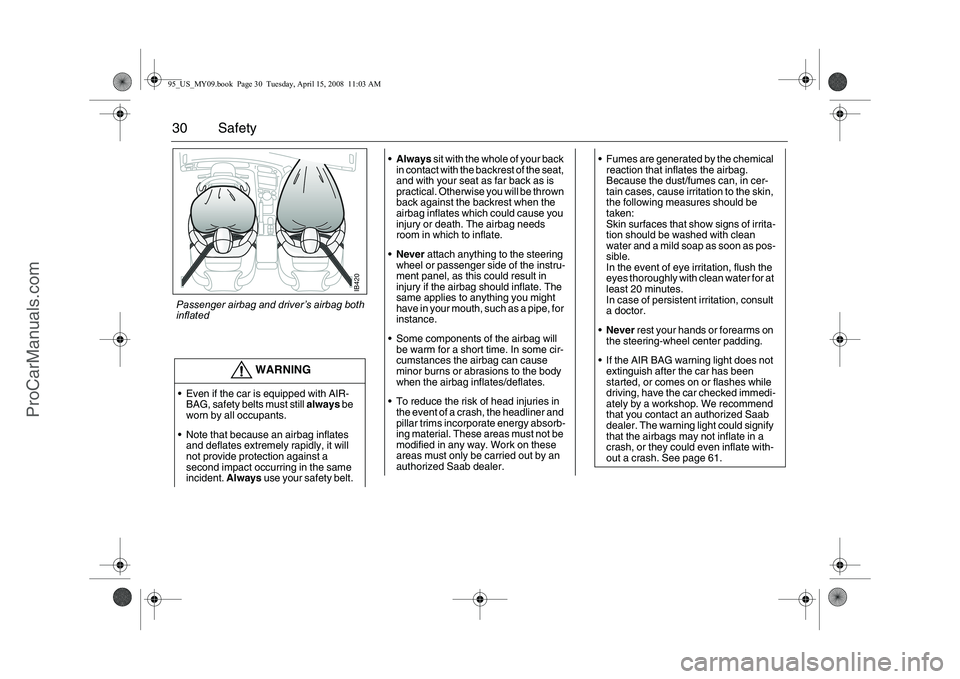
30 Safety
WARNING
Even if the car is equipped with AIR-
BAG, safety belts must still always be
worn by all occupants.
Note that because an airbag inflates
and deflates extremely rapidly, it will
not provide protection against a
second impact occurring in the same
incident. Always use your safety belt.
Always sit with the whole of your back
in contact with the backrest of the seat,
and with your seat as far back as is
practical. Otherwise you will be thrown
back against the backrest when the
airbag inflates which could cause you
injury or death. The airbag needs
room in which to inflate.
Never attach anything to the steering
wheel or passenger side of the instru-
ment panel, as this could result in
injury if the airbag should inflate. The
same applies to anything you might
have in your mouth, such as a pipe, for
instance.
Some components of the airbag will
be warm for a short time. In some cir-
cumstances the airbag can cause
minor burns or abrasions to the body
when the airbag inflates/deflates.
To reduce the risk of head injuries in
the event of a crash, the headliner and
pillar trims incorporate energy absorb-
ing material. These areas must not be
modified in any way. Work on these
areas must only be carried out by an
authorized Saab dealer.
Fumes are generated by the chemical
reaction that inflates the airbag.
Because the dust/fumes can, in cer-
tain cases, cause irritation to the skin,
the following measures should be
taken:
Skin surfaces that show signs of irrita-
tion should be washed with clean
water and a mild soap as soon as pos-
sible.
In the event of eye irritation, flush the
eyes thoroughly with clean water for at
least 20 minutes.
In case of persistent irritation, consult
a doctor.
Never rest your hands or forearms on
the steering-wheel center padding.
If the AIR BAG warning light does not
extinguish after the car has been
started, or comes on or flashes while
driving, have the car checked immedi-
ately by a workshop. We recommend
that you contact an authorized Saab
dealer. The warning light could signify
that the airbags may not inflate in a
crash, or they could even inflate with-
out a crash. See page 61.
IB420
Passenger airbag and driver’s airbag both
inflated 95_US_MY09.book Page 30 Tuesday, April 15, 2008 11:03 AM
ProCarManuals.com